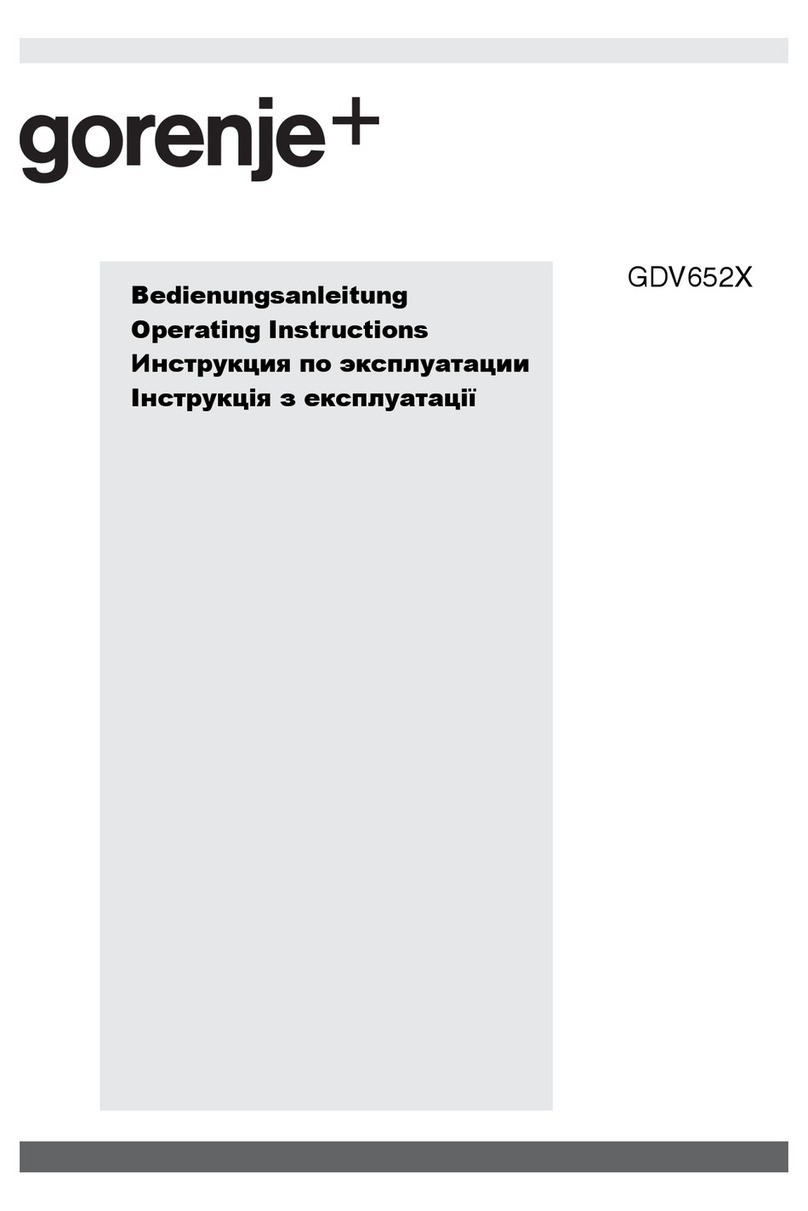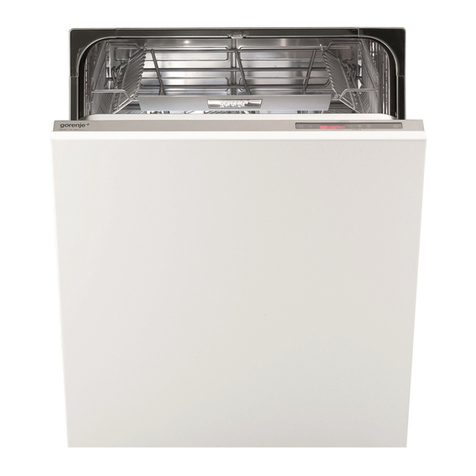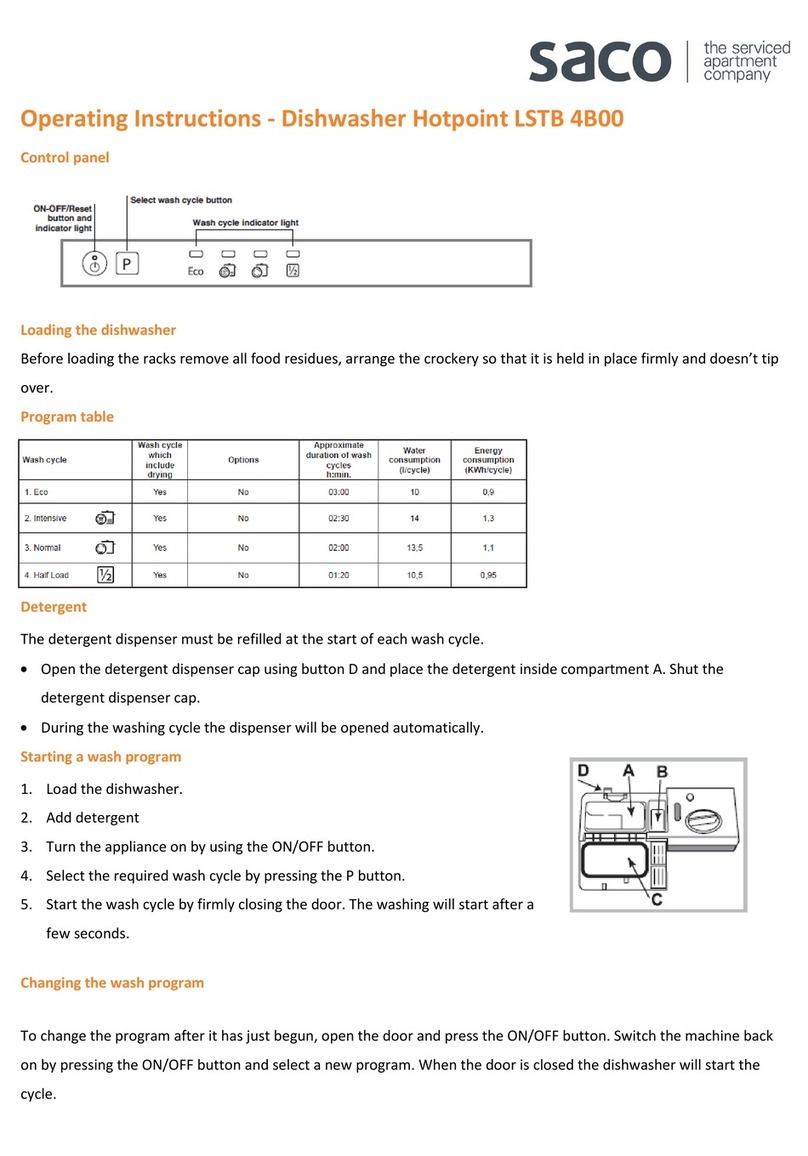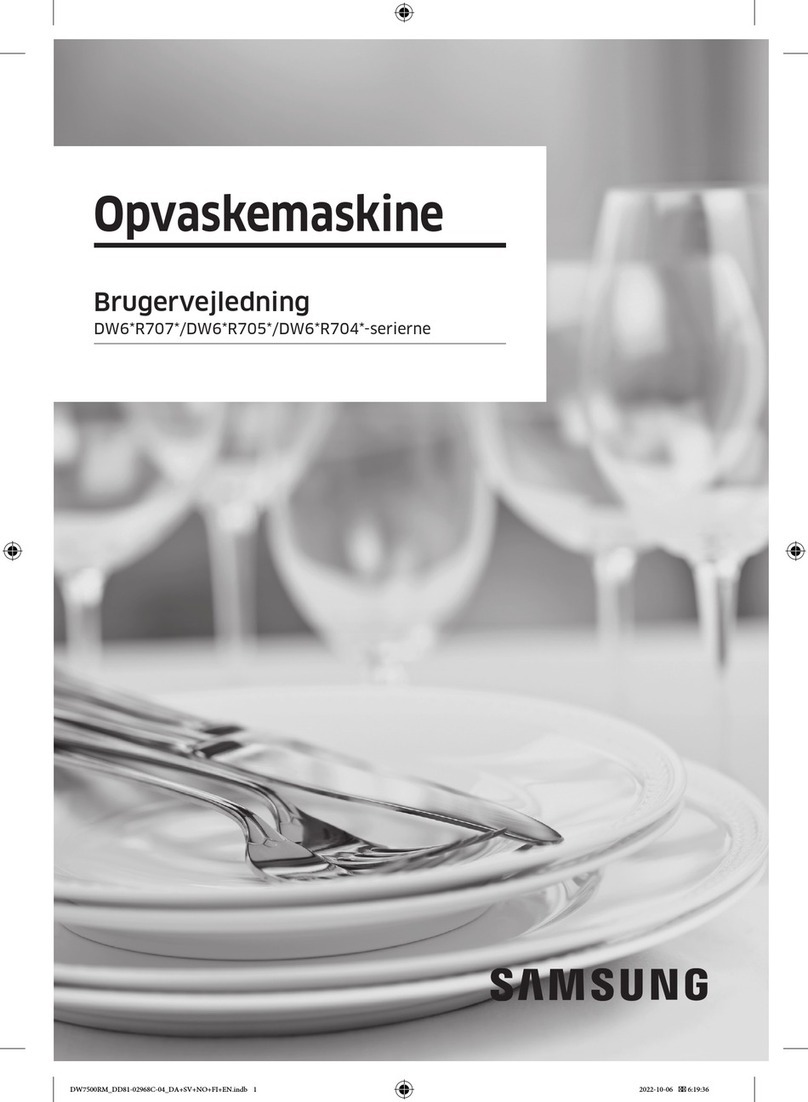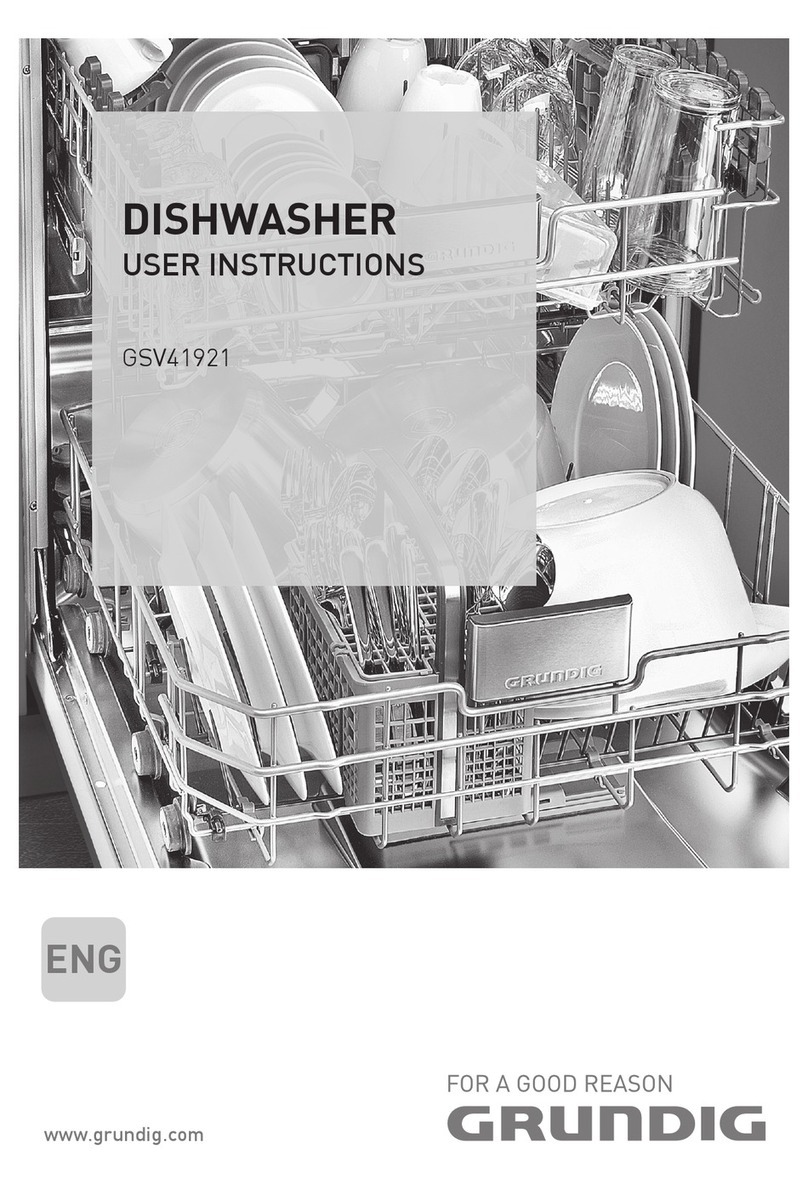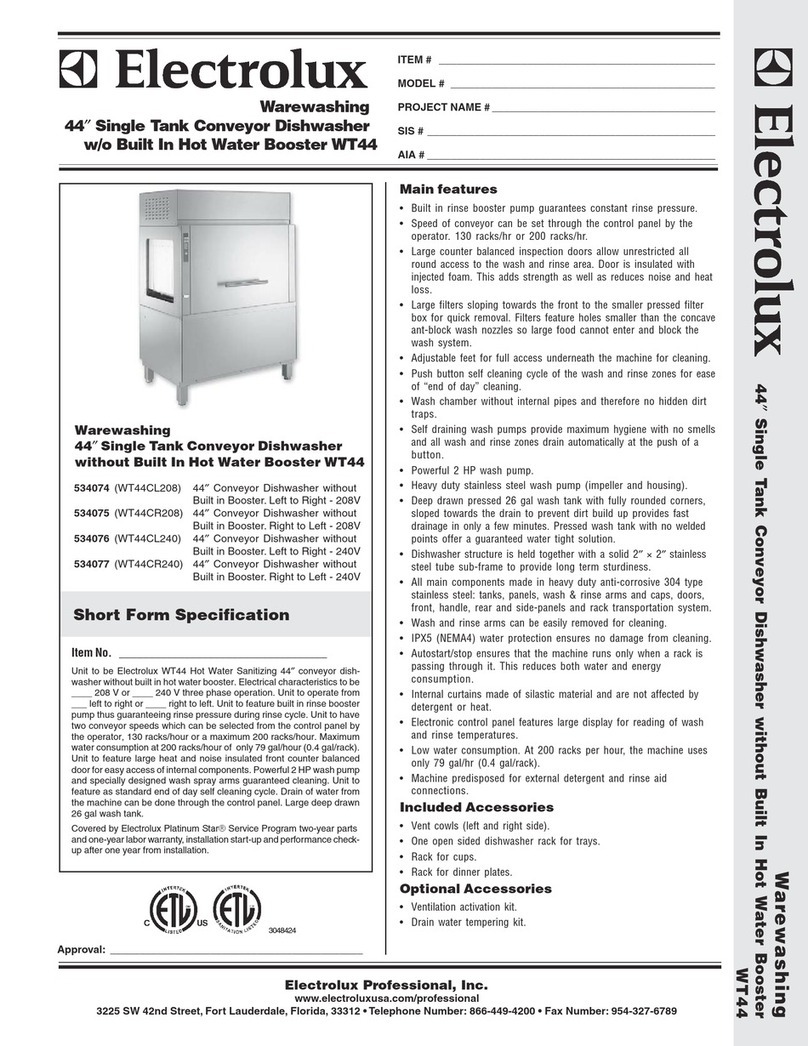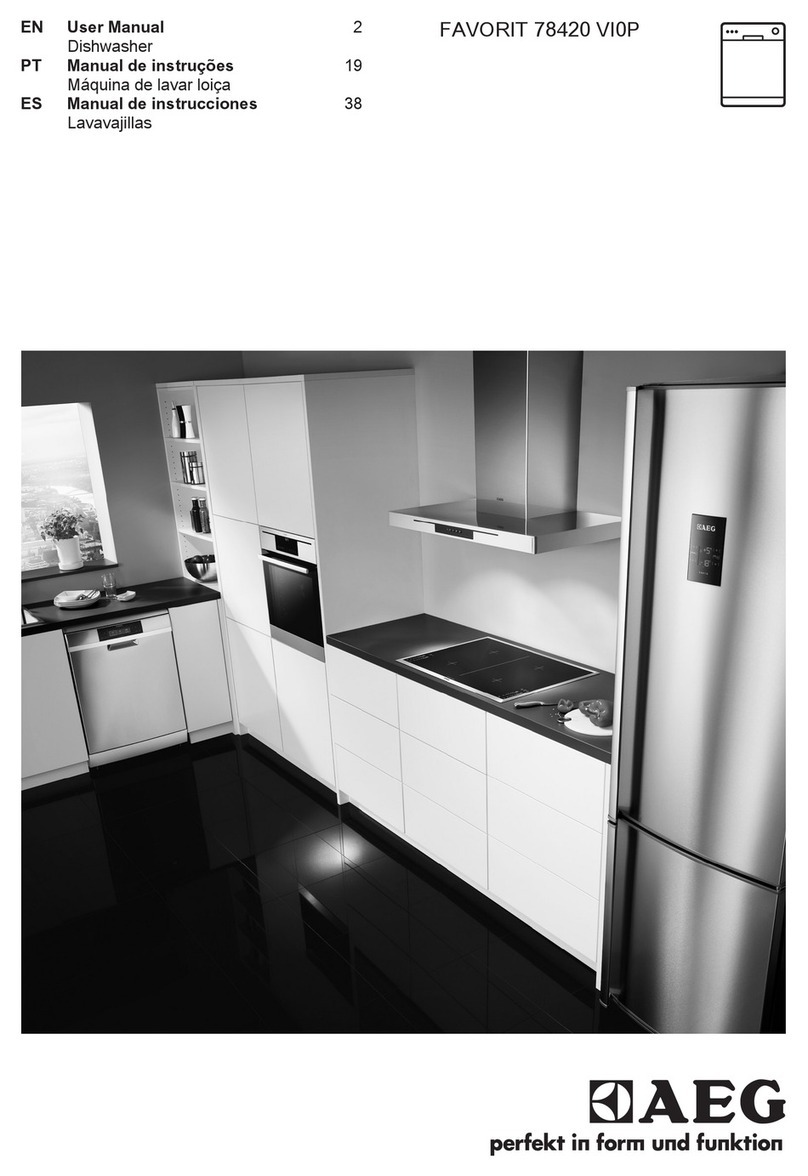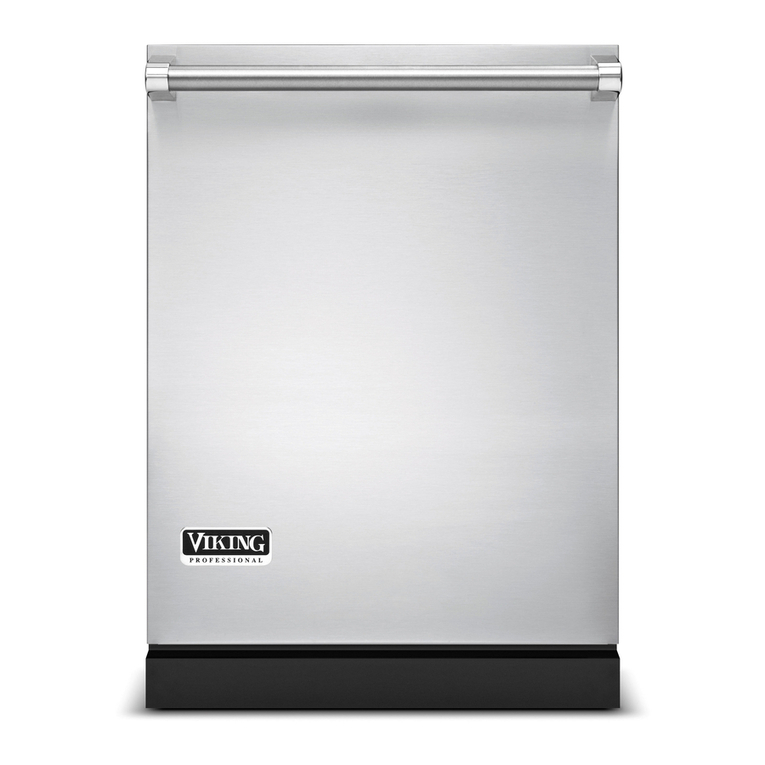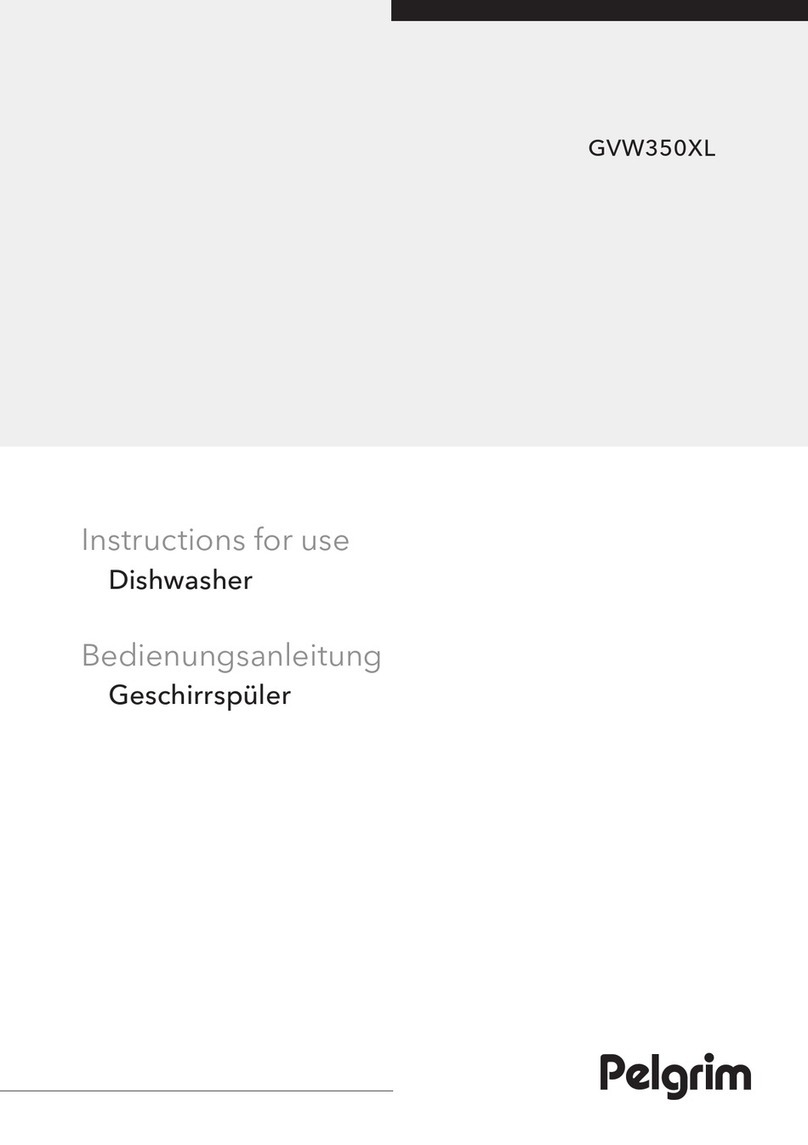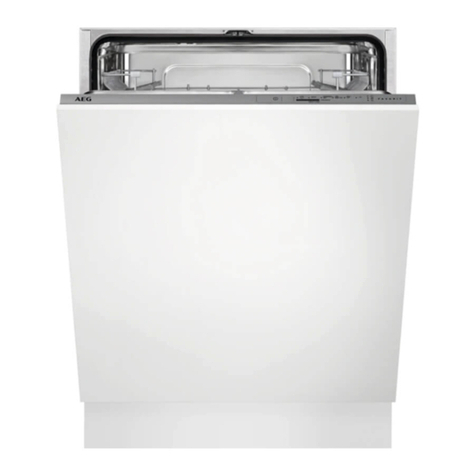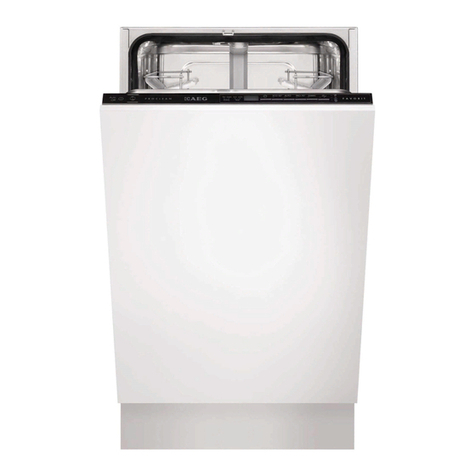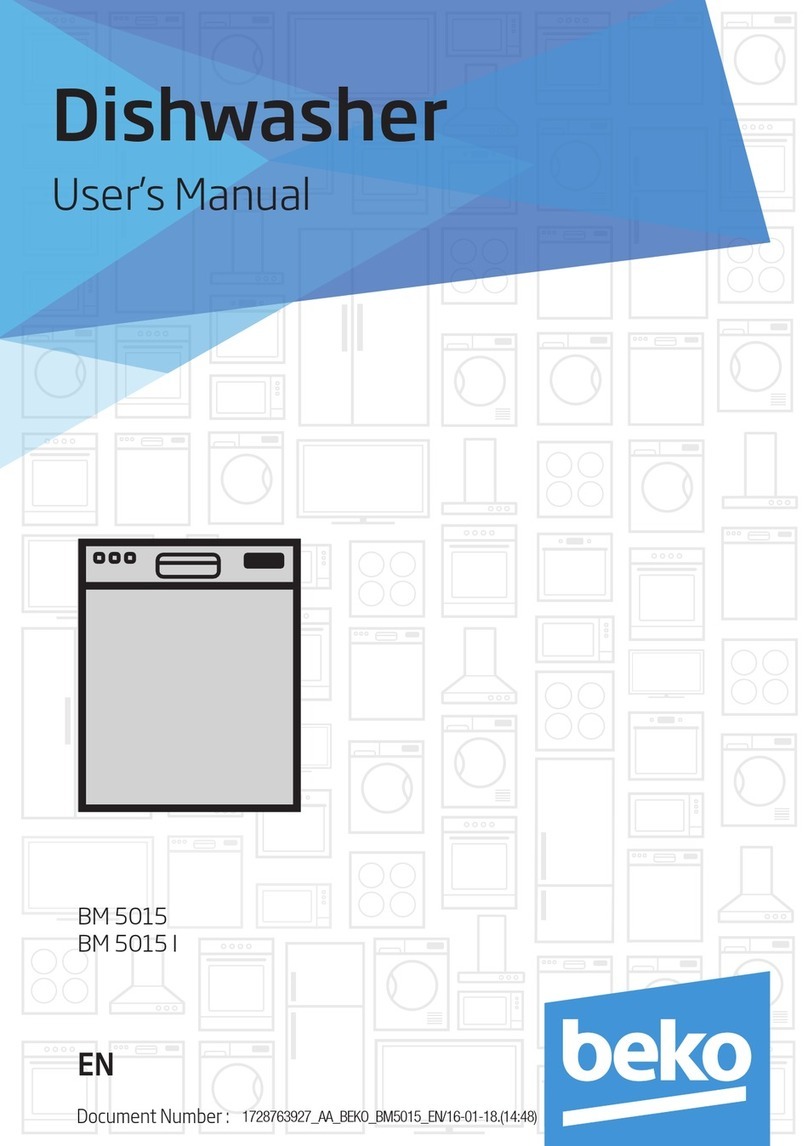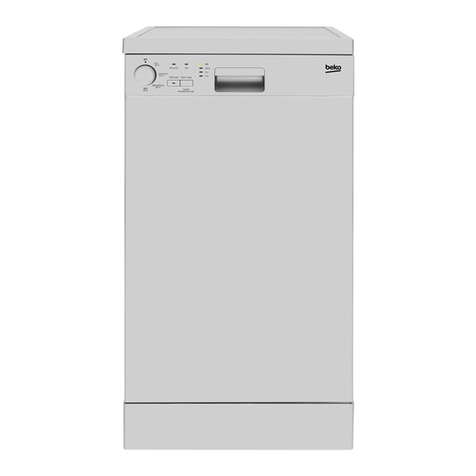Gorenje Plus GDV652X User manual

Operating Instructions GDV652X A

CONTENTS
2FRONT PANEL
3SAFETY INSTRUCTIONS
4
BEFORE WASHING FOR THE FIRST
TIME
6LOADING THE DISHWASHER
9USING THE DISHWASHER
13SETTINGS
17CARE AND CLEANING
20TROUBLESHOOTING
24INFORMATION FOR TEST INSTITUTE
25TECHNICAL INFORMATION
26INSTALLATION
28SERVICE
29PROGRAMME CHART
30YOUR NOTES
FRONT PANEL
The panel is fitted with touch buttons with audible feedback (see the chapter Settings).
1 32 5 6 9 10 11 12 13 14
7 8
4
1 On/Left-on mode
2 Programme selector
3 Programme symbol
4 Display
5 Rinse aid indicator
6 TAB (3-in-1/all-in-one
detergent)
7 Salt indicator
8 Child lock (button lock)
9 High temperature
10 Long dry
11 Delayed start
12 Set time (for the Time
program)
13 Time saver
14 Start/Stop
NOTE!
•Two minutes after the last button press, the panel backlight enters energy saving mode. Close and
reopen the door, or press the On/Left-on mode button, to reactivate the panel.
2

SAFETY INSTRUCTIONS
GENERAL
•Read the operating instructions and keep them
in a safe place!
•Never use the dishwasher for any purpose
other than that specified in these operating
instructions.
•Do not load the dishwasher door or
dishwasher baskets with anything other than
dishes.
•Never leave the dishwasher door open as
someone may trip on it.
•Use only dishwasher detergent!
•Place knives and other sharp items so that they
cannot harm anyone or damage the
dishwasher.
•The machine is not designed to be used by
persons (even children) that are physically or
mentally handicapped or lack experience and
knowledge. Such persons must receive
instruction in how to use the machine from
the person responsible for their safety.
•Children must be watched to ensure they do
not play with the dishwasher.
•Damaged mains cables must only be replaced
by a qualified electrician.
•This dishwasher is for household or similar
use, such as:
- staff kitchens in shops, offices and other
workplaces.
- farms.
-for guests at hotels, motels and other types
of accommodation.
- bed & breakfast hotels.
•Never place dishes with solvent residues in
the dishwasher due to the risk of explosion.
Nor may dishes that contain ash, wax or
lubricants be washed in the dishwasher.
INSTALLATION
See the section Installation.
CHILD SAFETY
•Use the knife stand for all long/sharp items.
•Always close the door and start the
programme immediately after you have added
the detergent.
•Keep children away from the dishwasher when
the door is open. Some detergent may remain
inside!
•Do not allow children to use or play with the
dishwasher. Be especially vigilant when the
door is open.
WARNING!
Children must be supervised –dishwasher
detergent is corrosive!
Store detergent and rinse aid out of the reach
of children! If anyone swallows dishwasher
detergent, they should immediately drink one
or two glasses of milk or water. Do not attempt
to induce vomiting. Contact a doctor! If anyone
gets dishwasher detergent in their eyes, rinse
(for at least 15 minutes) with plenty of water.
Activate child lock (button lock)
You can activate the child lock (button lock) to
prevent children from starting the dishwasher
(see the section Settings).
WINTER STORAGE/TRANSPORT
•Store the dishwasher where the temperature
remains above freezing.
•Avoid long transport distances in very cold
weather.
•Transport the dishwasher upright or laying on
its back.
OVERFLOW GUARD FUNCTION
The overflow protection starts pumping out the
machine and turns off the water supply if the
water level in the dishwasher exceeds the normal
level. If the overflow protection is triggered, turn
off the water supply and call the service division.
CLEANING
When cleaning the edge around the door, use
only a slightly damp cloth. Do not spray water
around the edge! Moisture can make its way into
the lock, which contains electrical components.
3

PACKING MATERIAL
Please sort waste materials in accordance with
local guidelines.
DISPOSAL
•When the dishwasher has reached the end of
its service life and is to be disposed of, it
should immediately be made unusable. Pull
out the power cable and cut it as short as
possible.
•The dishwasher is manufactured and labelled
for recycling.
•Contact your local authority for information
about where and how your dishwasher should
be correctly recycled.
BEFORE WASHING FOR THE FIRST
TIME
DEAR GORENJE+ CUSTOMER!
We hope that you will have many years of use
from your new machine.
The machine has many features. To make the
most of its functions, we recommend that you
read the operating instructions before using the
machine. The operating instructions include
information on how you can help protect the
environment.
PROGRAMME KEY
Some dishwashers include programme keys in
different languages. Attach the programme key
in the desired language to the top of the door.
THE WATER SOFTENER
In order to achieve good dishwashing results, the
dishwasher needs soft water (water with low
mineral content). Hard water leaves a white
coating on dishes and the dishwasher.
Water hardness is specified using the following
scales: The German water hardness scale (°dH)
and the French water hardness scale (°fH). A
water supply with a water hardness in excess of
6°dH (9°fH) must be softened. This is done
automatically with the aid of the built-in water
softener. In order for the softener to function
optimally, it must be adjusted to the hardness of
the water supply.
Contact the local waterworks to check the water
hardness in your area. Once you have adjusted
the water softener, use detergent and rinse aid
doses suitable for soft water.
ADJUSTING THE WATER SOFTENER
Chapter Settings, page 16 describes how to adjust
the water softener. Don't forget to fill the salt
compartment with salt after adjusting the water
softener.
4

FILL UP THE SALT
Before you begin using a dishwasher with a water
softener, you must fill the salt compartment with
salt. Use large grain salt or special dishwasher salt.
WARNING!
Top up the salt just before running a
programme. To avoid the risk of rust stains, the
dishwasher must be rinsed immediately after
topping up the salt.
Never pour dishwasher detergent into the salt
compartment. This destroys the water softener!
Do as follows the first time:
1 Unscrew the lid as illustrated.
2 Place the funnel supplied with the dishwasher
in the salt compartment top-up hole. First,
pour in about 1 l of water.
3 Then add salt, a maximum of 1.5 kg, until the
compartment is full.
4 Wipe up any excess salt so that the lid can be
screwed on firmly.
5 Run a programme to ensure that any salt in
the dishwasher is rinsed away.
Salt compartment lid
REFILL SALT INDICATOR
When the salt needs topping up, the above
symbol lights on the display.
When the salt runs out, unscrew the cap and fill
the container with salt. Water is only needed the
first time! Wipe clean and tighten. Run a
programme to ensure that any salt in the
dishwasher is rinsed away.
NOTE!
After topping up, it may take a while before the
symbol goes out.
TOP UP WITH RINSE AID
Drying is faster if you use rinse aid.
1 Open the rinse aid compartment lid.
2 Carefully top up with rinse aid. Only add rinse
aid to the level marked max.
3 Wipe up any splashes of rinse aid around the
compartment.
4 Close the lid firmly.
SELECTING THE RINSE AID DOSAGE
Rinse aid dispensing can be set from (Off)
to (High dose). (Factory settings: )
Increase the rinse aid dosage:
•If the dishes have water marks.
Decrease the rinse aid dosage:
•If the dishes have a sticky white/blue film.
•If the dishes are streaked.
•Build-up of foam. If you have very soft water,
the rinse aid can be diluted 50:50 with water.
SETTING THE RINSE AID DOSAGE
The section Settings describes how to set the rinse
aid dosage.
REFILL RINSE AID INDICATOR
When the rinse aid needs topping up, the above
symbol lights on the display.
NOTE!
After topping up, it may take a while before the
symbol goes out.
5

LOADING THE DISHWASHER
ECONOMIC DISHWASHING
Run programmes only with a full load
Wait to run a programme until the dishwasher is
full, this way you save energy. Use the Rinse &
Hold programme to rinse the dishes if there are
any unpleasant odours while you wait for the
dishwasher to become fully loaded.
Run programmes at a lower temperature
If the dishes are only slightly dirty, you can select
a lower temperature with certain programmes.
See also the section Selecting Options in the
chapter Using the dishwasher.
Select a programme with Short dry
To save energy, use Short dry. The drying result
will be better if, once the programme is finished,
you leave the door slightly open.
Do not rinse under running water
Simply scrape off large food particles before
loading the dishwasher.
Choose a green detergent
Read the environmental declaration on the
packaging!
Connect to cold water...
If you use oil or electricity to heat your home.
Connect to hot water (max. 70 °C)...
If you use district heating, solar power or
geothermal power to heat your home. Choosing
a hot water connection cuts programme times
and reduces the dishwasher's electricity
consumption.
FRAGILE DISHES
Some cookware is not dishwasher safe. This can
be for several reasons. Some materials cannot
withstand strong heat, others can be damaged by
dishwashing detergent.
Fragile decoration
Porcelain with decoration on top of the glazing
(the items feel rough) should not be washed in a
dishwasher.
Crystal/Glass
Position items so that they do not touch each
other during the wash. Use the lowest possible
wash temperature and the shortest possible
programme. Select Short dry. Antique and very
fragile items should not be washed in a
dishwasher.
Glass washed in a dishwasher at high temperatures
can gradually develop a grey film that cannot be
removed. Wash fragile glasses at a low
temperature and with a small amount of
detergent.
Silver
Silver and stainless steel items should not come
into contact, as the silver can become discoloured.
Cutlery with glued handles
Some types of glue are not dishwasher safe. In
such cases, the handles may loosen.
Wood
Wooden items should only be washed in a
dishwasher if marked dishwasher safe.
Aluminium
Aluminium can lose its shine if washed in a
dishwasher. However, good quality aluminium
pans can be washed in a dishwasher, even if some
of the shine will be lost.
Plastic items
Avoid washing plastic items that cannot withstand
high temperatures.
UPPER BASKET
Place glasses, cups, bowls, side plates and saucers
in the upper basket. Wine glasses are placed on
the wine glass shelf and knives are placed in the
knife stand on the right (if fitted).
NOTE!
All dirty surfaces should face inwards and
downwards!
6

MIDDLE BASKET
The middle basket's wire basket with spray pipes
is suitable for low objects. The middle basket's
utensils basket has space for ladles, whisks, serving
cutlery and similar items.
The wire basket can be replaced with another
utensils basket.
Wire basket
Utensils basket
Washing larger items
The two baskets in the middle basket can be
removed, or the entire middle basket can be
removed, to create more space between the
upper and lower baskets if larger items are being
washed.
NOTE!
Fit the supplied protective cap (in the enclosed
plastic bag) if the wire basket with spray pipes
or the entire middle basket is removed. Don't
forget to remove the protective cap when the
wire basket with spray pipes or the entire
middle basket is refitted.
Protective cap
LOWER BASKET
Place plates, side plates, serving dishes, pots and
cutlery (in the cutlery basket) in the lower basket.
Place pots and pans in the rear of the lower
basket to best utilise dishwashing performance
from the two rear spray nozzles, which are
intended for these types of dishes.
Fold-down plate supports
Lower the fold-down plate supports when
washing pots.
7

1
2 2
1
Forward mount for plate support
Used for plates with a diameter greater than 25
cm.
12
CUTLERY BASKET
Place cutlery with the handles facing down, except
for knives, and spread them out as much as
possible. Ensure that spoons do not stack inside
each other.
The cutlery basket is best placed in the middle at
the front of the lower basket to best utilise
dishwashing performance from the unique spray
nozzle, which is intended for the cutlery basket.
NOTE!
Do not place cutlery made of different
materials, such as silver and stainless steel, in the
same place (risk of discolouration).
WARNING!
Knives and other pointed items must be placed
with the points down in the cutlery basket or
horizontally in other baskets.
Fold-down section for small items
The cutlery basket has a fold-down section in the
middle for small items, or small shafts, such as
electric whisk attachments.
ac
b
Cutlery basket with lid
ac
b
Positioning of cutlery basket lid (in upper
basket)
The cutlery basket lid can be removed and used,
for example, as an extra cutlery basket in the
upper basket (see below).
ab
8

USING THE DISHWASHER
ADD DETERGENT
1 Prewash detergent compartment
2 Main wash detergent compartment
Detergent is added according to water hardness.
Follow the instructions on the detergent
packaging. This dishwasher is fitted with a water
softener, so use detergent and rinse aid doses
suitable for soft water.
Too much detergent can result in less effective
dishwashing and also entails greater environmental
impact.
Add the detergent to the detergent compartment.
There is one compartment for the prewash and
one for the main wash. If tablets are not used, add
a small amount of the detergent to the prewash
compartment. Contact the detergent
manufacturer if you have any questions about the
detergent.
WARNING!
Children must be supervised –dishwasher
detergent is corrosive!
NOTE!
Use only dishwasher detergent! Washing up
liquid must not be used as the foam that forms
prevents the dishwasher from operating
effectively.
Dishwasher tablets
Halve the tablet if it is difficult to close the
dispenser lid. There is a risk that the detergent
will not be released properly if the lid is tight and
will not open correctly.
NOTE!
Dishwasher tablets are not recommended for
short programmes (less than 75 minutes). Use
powder or liquid dishwasher detergent instead.
3-in-1/All-in-one detergent
Read through the directions for these products
carefully. If anything is unclear, contact the
detergent manufacturer.
PROGRAMME SELECTION
Press the Programme selector one or more times
until the desired programme symbol appears on
the display.
Auto wash
The dishwasher can measure how dirty the dishes
are and adjust water consumption and
temperature accordingly. When newly installed,
the programme needs to be run five times before
it is fully adapted and can provide the best results.
Time program
The programme adapts to the specified running
time or finish time. With this programme it is
important to choose a time suited to how dirty
the dishes are.
Slightly dirty dishes0:30-1:15
Normally dirty dishes1:30-2:00
Very dirty dishes2:15-3:00
To set the programme time, see the section
Selecting Options.
Heavy wash
Programme for very dirty dishes, such as pans,
casserole dishes and oven dishes. If these dishes
do not completely fill the dishwasher, you can add
plates and the like.
9

Normal wash
Powerful programme for daily use that can
remove dried leftovers, but is not intended for
burnt food, such as on oven dishes. This
programme provides maximum rinse effect, and
takes longer than Daily wash.
Daily wash
This is also an effective programme for daily use
for slightly dried leftovers, but is not intended for
burnt food, such as on oven dishes.
Quick wash
This programme is used for glasses and porcelain
that is slightly dirty, such as coffee cups.
Super Quick wash
Short programme lasting about 15 minutes with
acceptable results for very slightly dirty dishes.
Delicate wash
If the dishes are not very dirty, you can select
Delicate wash. This programme is intended for
glasses and porcelain that have just been used and
as such do not require such a powerful
programme.
This programme can be used for fragile dishes.
Select Short dry if you want to be especially
cautious. See also the section Fragile dishes in the
chapter Loading the dishwasher.
Eco wash
This programme is intended for cleaning normally
dirty dishes and is the most effective programme
in terms of combined energy and water
consumption.
The High temperature option must be selected
to access the programme used to compile the
information for energy labelling.
Upper half wash
You can use this programme if you only have cups
and glasses that need washing in the upper basket.
Slightly dirty dishes can also be placed in the lower
basket.
Lower half wash
You can use this programme when you only want
to wash plates and cutlery in the lower basket.
Slightly dirty dishes can also be placed in the upper
basket.
Rinse & Dry
This programme comprises a rinse with heating
and drying. This is a suitable programme if, for
example, you plan to make jam and want to rinse
and heat clean glass jars.
Rinse & Hold
Used to rinse dishes while you wait for the
dishwasher to become fully loaded.
SELECTING OPTIONS
To select an option, press one of the option
buttons. The field under the button lights when
the option is activated. The available options
depend on the selected programme. Once you
have started the programme, the options you
selected are saved for the next time you use the
same programme. An exception is the Delayed
start option.
High temperature
Activate this option for improved dishwashing
results. The machine then uses a higher
temperature for the main wash. This option
cannot be activated if the Time saver option is
selected.
If you want to use the lower temperature, press
again so that the field under the button turns off.
10

You can vary the temperature as shown below:
60 °C / 70 °CHeavy wash:
60 °C / 65 °CNormal wash:
60 °C / 65 °CDaily wash:
30 °C / 60 °CQuick wash:
30 °C / 60 °CSuper Quick wash:
40 °C / 50 °CDelicate wash:
50 °C / 60 °CEco wash:
55 °C / 65 °CUpper half wash:
55 °C / 65 °CLower half wash:
Long dry
A higher temperature in the final rinse and a
longer drying phase improves the drying result if
you activate the Long dry option. This causes a
slight increase in energy consumption. This option
can be used with all programmes except Time
program, Rinse & Dry and Rinse & Hold. This
option cannot be activated if the Time saver
option is selected.
If you want a programme with Short dry, press
again so that the field under the button turns off.
Delayed start
When you select Delayed start, the dishwasher
will start 1-24 hours after you press the Start/Stop
button.
1 Press the button once to activate Delayed
start. Press the button several times –or hold
it in –to set the desired number of hours.
2 Press Start/Stop and the dishwasher counts
down 1 hour at a time and starts after the
selected delay.
Press and hold Start/Stop for three seconds if you
want to cancel the Delayed start option.
NOTE!
Remember to press the Start/Stop button to
start the programme.
Set time
Press the option button several times –or hold
it in –to set the desired programme time for
Time program. You can choose a programme
time between 30 minutes and 3 hours.
Time saver
This option shortens the programme time, but
uses more energy and water. This option can be
selected with the programmes Heavy wash,
Normal wash, Daily wash, Upper half wash and
Lower half wash.
START THE DISHWASHER
Press and hold Start/Stop until the display shows
(the door open symbol). This indicates
that the dishwasher is ready to start. Close the
door properly, otherwise the dishwasher will not
start.
NOTE!
If the machine does not start within 2 minutes
of the last button press, the display returns to
showing the last programme run.
TIME REMAINING
Once you have selected a programme and
options, the display indicates how long the
programme took the last time it was used. The
remaining time is updated after the water for the
final rinse has been heated.
This may differ somewhat from time to time
depending on the temperature of the water
supply, the amount of dishes, the ambient
temperature and other factors.
NOTE!
During the first run of each programme, the
remaining time displayed can be slightly
misleading, as the dishwasher is estimating the
time. When you run the programme a second
time, the dishwasher will calculate the remaining
time based on the previous duration of the
programme.
11

STATUS LIGHT
The status light at the bottom on the dishwasher
provides information by means of 3 different
colours. Adjust the status light so that it is seen
clearly by pulling out or pushing in the transparent
plastic strip.
Status light
Blue
Load more. The programme has started, but you
can still load more dishes.
Red
Do not load. You should not load more dishes
(risk of poorer dishwashing result).
Flashing red
This indicates a fault. See further in the section
Troubleshooting.
Green
Unload. The dishwashing programme is finished.
Standby light for two hours.
STOPPING OR CHANGING A
PROGRAMME
If you want to change programme after starting
the dishwasher, open the door then press and
hold Start/Stop for three seconds. Add more
detergent if the lid of the detergent dispenser has
opened. Then choose a new programme, press
Start/Stop and close the door.
DO YOU WANT TO ADD MORE DISHES?
Open the door. The dishwasher stops
automatically. Add the dishes, close the door and
the dishwasher continues the programme.
IF THE DISHWASHER IS TURNED OFF
USING THE ON/LEFT-ON MODE BUTTON
OR DUE TO A POWER FAILURE
If the dishwashing programme was not finished,
the interrupted programme continues when
power is restored.
NOTE!
During drying, the programme is interrupted if
the power is cut or the door is open for more
than 2 minutes.
ONCE THE PROGRAM HAS FINISHED
Once the programme has finished and the door
is opened "End" appears on the display.
A buzzer also sounds at the end of the
programme. See the section Settings, which
describes how to change this function.
A status light also indicates the end of the
programme. See the section Status light in the
chapter Using the dishwasher.
Once the dishwasher has finished, it uses only
standby power. Turn off the water supply valve
after each use.
12

SETTINGS
DO AS FOLLOWS TO OPEN THE SETTINGS MENU:
First, open the door. Turn off the dishwasher using the On/Left-on mode button
(press and hold). Release the button.
1.
Press and hold the On/Left-on mode button until the display lights up.2.
Within five seconds, press and hold the Programme selector and the Long dry
button.
3.
+
Release the buttons when the display shows .4.
TIP!
Be sure to press right on the symbols, so as not to inadvertently activate any
other button. Try again if you fail to open the settings menu the first time.
Press to save the set value and continue to the next setting.
Current setting.
Current setting value.
Press to browse between setting values.
YOU CAN NOW ADJUST THE FOLLOWING SETTINGS:
DescriptionSettingsOptionsButton press
You can activate the child lock
(button lock) option to prevent
children from starting the dish-
washer.
Child lock
(button lock)
(Off)
(On)
Press the High temperature and
Long dry buttons simultaneously
to temporarily deactivate the but-
ton lock when you want to start
the dishwasher. The button lock
is automatically reactivated after
2 minutes.
Press Start/Stop to save the setting value and continue to the next setting.
If you do not want to change any other settings, keep pressing Start/Stop to step through
the entire settings menu.
13

DescriptionSettingsOptionsButton press
The dishwasher uses a buzzer to
indicate when a programme is
finished or when a fault has oc-
curred.
Buzzer volume
(Off)
(Low)
(High)
Press Start/Stop to save the setting value and continue to the next setting.
This sound is used to confirm each
button press.
Operation
volume
(Off)
(Low)
(High)
Press Start/Stop to save the setting value and continue to the next setting.
For adjusting the contrast of the
display on the panel.
LCD contrast
(Low)
(High)
Press Start/Stop to save the setting value and continue to the next setting.
Rinse aid dosage setting.Rinse aid
(Off)
(Low dosage)
(High dosage)
Press Start/Stop to save the setting value and continue to the next setting.
14

DescriptionSettingsOptionsButton press
This option can be activated when
using 3-in-1/all-in-one detergents.
The dishwashing programme
automatically adapts to provide
the best possible dishwashing and
drying results every time. If you
deactivate this option, the dish-
washer will return to ordinary
function for all programmes.
If this setting is activated there is
no need to add rinse aid since this
option disables rinse aid dispens-
ing. It also reduces the amount of
salt added to the water softener.
NOTE!
In order to achieve good dish-
washing results, it is essential to
check which type of detergent
or all-in-one product best suits
your needs! Read the detergent
packaging carefully for informa-
tion on proper use. Always fol-
low the directions for use or in-
formation on the detergent
packaging!
TAB
(3-in-1/all-in-one
detergent)
(Off)
(On)
Press Start/Stop to save the setting value and continue to the next setting.
15

DescriptionSettingsOptionsButton press
Adjusting the water softener.
Read off the appropriate setting
from the water hardness table
below.
°dH
0-5
6-8
9-11
12-14
15-19
20-24
25-29
30-39
40-49
50+
0-9
10-14
15-20
21-25
26-34
35-43
44-52
53-70
71-88
89+
°fH
Water hardness
(Soft water)
(Hard water)
Press Start/Stop to exit the settings menu.
16

CARE AND CLEANING
COARSE FILTER
The coarse filter traps larger food particles, which
cannot get past the drainage pump. Empty the
coarse filter as necessary.
1 Lift the coarse filter by the handle.
2Empty the coarse filter. Remember to replace
it!
Coarse filter
FINE FILTER
Debris that collects on the fine filter is
automatically rinsed away during each wash.
However, the fine filter and its pipe section should
be cleaned a couple of times a year.
1 Turn the handle anticlockwise once.
1x
Fine filter
2 Lift the pipe section straight up by the handle.
Free the coarse filter to clean the pipe section.
3 Remove and clean the fine filter.
4Replace in reverse order. Check that the edges
seal properly when replacing the fine filter.
Pipe section
5 Lock the filter in place by turning the handle
clockwise to the stop position. The handle
should point straight out from the dishwasher.
1x
NOTE!
The dishwasher must not be used without the
filters in place!
Dishwashing results may be affected if the
coarse filter is incorrectly fitted.
DRAINAGE PUMP
The pump can be accessed from inside the
dishwasher.
1 Cut the power to the dishwasher by pulling
out the plug from the wall socket!
2 Remove the coarse filter and pipe section.
3 Remove the small yellow fitted piece at the
left of the bottom drain (see illustration
below).
4 By inserting your finger into the hole you can
turn the pump blade to release anything
blocking it.
5 Reinstall the fitted piece and filters.
6 Plug the machine in again.
If the dishwasher still does not start and a
whirring sound is heard, the overflow
protection has been activated.
17

•Shut off the water.
•Remove the plug from the wall socket.
•Call the service division.
NOTE!
Do not forget to reinstall the fitted piece.
LOWER SPRAY ARM
Holes and bearings can sometimes become
blocked.
1 Pull the lower spray arm straight up to release
it.
2 Remove any debris using a needle or the like.
The spray arms also have holes underneath.
UPPER SPRAY ARM
1 Pull out the basket.
2 Unscrew the spray arm bearings as illustrated
to remove the spray arm from the upper
basket.
Spray arm bearings
3 Clean the upper spray arm in the same
manner as the lower spray arm.
4 Replace the spray arm and screw the spray
arm bearings firmly back into place.
CLEANING THE MIDDLE BASKET
1 Pull out the basket.
2 Check the holes in the spray pipe.
Spray pipes
3 Clean with a needle or the like.
18

DOOR
When cleaning the edge around the door, use
only a slightly damp cloth (with a little cleaner if
necessary).
WARNING!
Do not use a spray bottle or the like around the
door lock. This is to ensure that water does not
penetrate the door catch and come into contact
with the electrical components.
LIMESCALE DEPOSITS
The dishwasher tub is made of stainless steel and
is kept clean through normal use. However, if you
have hard water, limescale deposits may form in
the dishwasher. If this happens, run the Normal
wash programme with high temperature and two
tablespoons of citric acid in the detergent
compartment (with no dishes in the machine).
FRONT PANEL
Keep the touch buttons clean and free from
grease. Wipe them clean with a dry or slightly
damp cloth. Never use cleaners –they can scratch
the surface. Use the On/Left-on mode button to
turn off the dishwasher before cleaning the touch
buttons to avoid activating any buttons
unintentionally.
19

TROUBLESHOOTING
ActionType of faultDisplay
Call the service division.Overfilling
See "Water remains in the dishwasher"
in the table below.
Water outlet fault
Check that the water tap is on.Water inlet fault
Turn off the water tap and call the ser-
vice division.
Inlet valve leakage
Turn off the machine with the On/Left-on mode button and then turn it on again to clear the error
message from the display.
ActionPossible causesProblem
Remove the arms and clean them.The spray arms do not rotate.The dishes are not clean.
Check that the dishes are not
blocking the spray arms.
Avoid large packages.Old detergent. Detergent is a
perishable product.
Dose according to water hard-
ness. Far too much or far too little
detergent results in poorer dish-
washing results.
Incorrect detergent dosage.
Select a higher temperature or a
more powerful programme.
Dishwashing programme too
weak.
Do not cover porcelain with large
bowls or the like. Avoid placing
very tall glasses in the corners of
the baskets.
Dishes loaded incorrectly.
Place dishes to sit steady.Glasses and cups have toppled
over during the programme.
Screw the filter firmly into place.
See the section Care and cleaning.
The filter is not correctly fitted.
20
Other manuals for GDV652X
1
Table of contents
Other Gorenje Plus Dishwasher manuals

